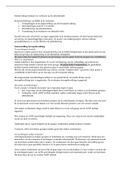Exam (elaborations)
Marketing Management 2nd Edition By Marshall - Test Bank
- Module
- Marketing - Test Bank
- Institution
- Marketing - Test Bank
Chapter 02 Elements of Marketing Strategy, Planning, and Competition True / False Questions 1. Value is defined by the customer. True False 2. A benefit is some type of utility that a company and its products provide for customers. True False 3. Starbucks is known...
[Show more]




